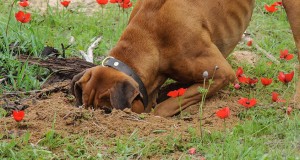Strange facts about canine instincts
Every dog is born with a number of natural behaviors, things they can do without having to be trained or taught.
Certain breeds have incredibly visible canine instincts, such as guarding or herding behavior, or strong natural hunting abilities. These are instincts that have been intentionally bred into these dogs over generations.
But while dogs can be bred to encourage particular skills and behaviors, there are also a number of natural instincts that every canine shares. Many of them are so innocuous or understandable that most Pack Leaders don’t even think about them.
Some examples include dogs’ inborn ability to learn through nose, eyes, and ears — in that order — or their natural inclination to guard their food, space, and pack. And did you know that dogs come into the world programmed to work not only for rewards, but also for their food?
When you understand your dog’s instinctual behaviors, you are better able to meet his needs, improve your relationship with him, and be accepted as the leader of your pack. With that in mind, below we’re going to explore several natural dog behaviors and why your furry companion engages in them.
Strange facts about six canine instincts
You can intuitively understand why your dog may want to guard his food or space. And you’ve likely heard that a dog’s nose is her most important sensory organ — which explains her obsession with sniffing things out.
But what about other behaviors? The odd things that don’t seem to make sense? Here are just a few canine instincts that you may find baffling.
Licking
Does he just like you that much? Do you taste good? What is it? First, let’s get it out of the way: Yes, licking can be a way your dog says he likes you. But dogs also lick to clean, to communicate, and to calm themselves down. Mother dogs even lick newborn pups as a way to get them to breathe.
Tail wagging
Yet another way dogs “talk” to each other — and to you. And it’s actually pretty simple once you understand the “language.” Wagging to the right means she’s happy, while wagging to the left means she’s scared.
Butt sniffing
Stop me if you’ve heard this before: “Dogs sniff each other’s butts as a greeting.” Technically this is true, but it’s only the tip of the iceberg. Your dog’s sense of smell is so good that when he sniffs another dog’s rear, he can learn about their diet, gender, emotional state, and more.
Burying
Is your dog just bored when she buries her toys? Is it a game? Not exactly. Wild dogs had to bury their food so no one else would come along and steal it before they were ready to eat it. When your dog buries a toy, it’s her way of saying, “This is mine, and I have to protect it.”
Trailing — or leading
Which one of these sounds like your typical dog walk? 1) You get dragged around the neighborhood the second the leash goes on. 2) You feel like you’re constantly tugging your dog to catch up and walk next to you. 3) You walk serenely side-by-side or in front of your dog. This is an instinctual behavior that you’ll have to work on with your dog.
In the wild, dogs naturally gravitate to one of three spots: the front, where they guide the way and handle danger; the back, where they follow and warn of dangers from the rear; or the middle, where they relay messages from the front to the back.
Humans should always be the Pack Leaders, which means you lead and your dog follows. If this isn’t your dog’s natural place, the best way to teach this behavior is to exhibit calm, assertive leadership and correct your dog when she isn’t walking properly. If you have more than one dog, it’s important to let them define their place in the pack without your input.
Rolling in grossness
Picture this. It’s a typical walk with your dog. Suddenly you spot a dead and decaying bird. It makes you a little bit sad, but other than that, you have no reaction. Your dog, however, sprints to the bird. You think he’s going to eat it, but what he has in mind is far more disgusting: he rolls in it, smearing the carcass all over his body. Why?
Wild instincts strike again. Out in nature, dogs have to hunt for their food. But if your prey can smell you a mile away, you’re not going to eat much. So they camouflage their odor. By rolling around in gross, disgusting things that have strong smells. Blech!
Obviously, these are not the only strange behaviors that dogs naturally engage in due to their natural canine instincts. What are some things that your dog does?
